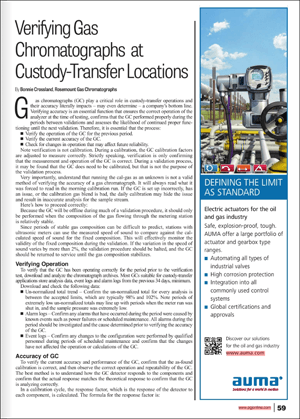Gas chromatographs (GCs) are used in natural gas custody transfer applications. They provide information on the gas quality and composition—with components such as methane, ethane and heavier hydrocarbons, water vapor, carbon dioxide, nitrogen and hydrogen sulfide. These gas chromatograph are normally located on large gas stations with dedicated buyer use.
In a Pipeline & Gas Journal article, Verifying Gas Chromatographs at Custody-Transfer Locations [free subscription required], Emerson’s Bonnie Crossland describes the importance of accuracy verification for the gas chromatograph.This verification process assures proper operation and is performed between natural gas steam validation cycles.
 Bonnie opens sharing the essential steps in GC validation:
Bonnie opens sharing the essential steps in GC validation:
- Verify the operation of the GC for the previous period.
- Verify the current accuracy of the GC.
- Check for changes in operation that may affect future reliability.
She contrasts GC verification from calibration:
During a calibration, the GC calibration factors are adjusted to measure correctly. Strictly speaking, verification is only confirming that the measurement and operation of the GC is correct.
Bonnie notes that this validation process should only be performed during periods of flow stability:
…stations with ultrasonic meters can use the measured speed of sound to compare against the calculated speed of sound for the fixed composition. This will effectively monitor the validity of the fixed composition during the validation. If the variation in the speed of sound varies by more than 2%, the validation procedure should be halted…
Gas chromatographs used in custody transfer applications typically store more than a month of analysis data, event and alarm logs to verify correct operation over time.
The GC calibration process involves the use of “reference” and “measure” thermistors that change in resistance with changes in temperature.
The magnitude of the detector output is dependent on the difference in thermal conductivity of the gases passing over the reference and measure thermistors.
…
If the magnitude of the response factors is not in the correct order, it indicates there is a calibration effort from the gas chromatograph that must be rectified before the validation can be completed.
After confirming accuracy, the GC is run through a five-step calibration cycle to confirm that the GC will correctly calibrate and the accuracy will not be affected. Any deviations cause the validation to fail.
Read the article for more specifics on these five steps using the calibration gas, repeatability specifications, response factors, checking for changes over time, and verification reports. Bonnie concludes:
Armed with this “gold standard” methodology, custody-transfer operations can be assured of accuracy, meet contractual obligations and ensure the bottom line.
You can connect and interact with other GC and analyzer experts in the Analytical group in the Emerson Exchange 365 community.

